Did you know that pea shoots are not only delicious but also incredibly nutritious? These delicate and vibrant greens, also known as microgreens, are packed with essential vitamins, minerals, and antioxidants. Adding a handful of fresh pea shoots to your meals can elevate them from ordinary to extraordinary and provide a powerful boost of plant-based nutrition.
Pea shoots, commonly used as salad toppings or culinary greens, are not only a healthy vegetable but also a culinary herb. They have become increasingly popular as people embrace organic produce and seek out versatile and nutrient-dense ingredients for their meals. With their tender texture and mild pea flavor, they have the potential to completely transform the way you enjoy your greens.
Key Takeaways:
- Pea shoots are nutritious greens that belong to the category of microgreens.
- Adding pea shoots to your meals can provide a powerful boost of plant-based nutrition.
- Pea shoots are versatile and can be used as salad toppings or culinary herbs.
- They are packed with essential vitamins, minerals, and antioxidants.
- Embracing fresh pea shoots can elevate your meals from ordinary to extraordinary.
Difference Between Pea Shoots and Pea Sprouts
When it comes to pea shoots and pea sprouts, the main difference lies in their growing methods and appearance.
Pea shoots are the leaves and young tendrils that grow in the soil. They have darker-green stems and bigger leaves, giving them a lusher and more vibrant appearance. Pea shoots are often harvested when they are several inches tall, and their tender leaves and stems are commonly used in salads, stir-fries, and garnishes.
On the other hand, pea sprouts are sprouted peas that are grown in water. They have long, light-green stems and tiny leaves, which are the early stages of the pea plant. The sprouts are typically harvested when the white roots start to emerge, usually after two to three days of germination. Pea sprouts have a delicate texture and a mild flavor, making them ideal for adding a fresh crunch to salads, sandwiches, and wraps.
In summary, while pea shoots are the leaves and young tendrils grown in the soil with darker-green stems and bigger leaves, pea sprouts are germinated peas grown in water with long, light-green stems and tiny leaves.
Comparison Between Pea Shoots and Pea Sprouts
| Pea Shoots | Pea Sprouts |
|---|---|
| Grown in soil | Grown in water |
| Darker-green stems | Light-green stems |
| Bigger leaves | Tiny leaves |
| Ideal for salads, stir-fries, and garnishes | Great for salads, sandwiches, and wraps |
Health Benefits of Pea Shoots
Pea shoots, commonly categorized as microgreens, offer a plethora of health benefits. These vibrant greens are not only delicious but also packed with essential nutrients that promote overall well-being. Let’s explore the various health benefits that pea shoots provide:
Rich in Antioxidants and Vitamins
Pea shoots are a powerhouse of antioxidants, which play a vital role in protecting the body against harmful free radicals. These antioxidants help combat oxidative stress and reduce the risk of chronic diseases, including heart disease and cardiovascular disease. Consuming pea shoots may help lower LDL cholesterol and triglycerides levels, reducing the risk of plaque buildup and maintaining a healthy cardiovascular system.
In addition to antioxidants, pea shoots are a fantastic source of vitamins. They contain significant amounts of vitamin K, known for its role in promoting blood clotting and bone health. Pea shoots also provide ample amounts of vitamin C, which supports the immune system and aids in collagen production. Vitamin A and vitamin E, both found in pea shoots, act as powerful antioxidants, protecting the body from cellular damage. Furthermore, these greens offer essential B vitamins such as folate, riboflavin, thiamin, and vitamin B-6, which are crucial for energy production and maintaining a healthy nervous system.
Loaded with Phytochemicals and Carotenes
Pea shoots contain phytochemicals, such as quercetin and caffeic acid, which possess anti-inflammatory properties. These compounds help reduce inflammation in the body and may contribute to the prevention of chronic diseases.
Moreover, pea shoots are rich in carotenes, which are plant-derived pigments responsible for their vibrant colors. Carotenes function as powerful antioxidants, protecting the body against cellular damage caused by free radicals. These compounds also exhibit provitamin A activity, meaning they can be converted into vitamin A by the body, supporting healthy vision, immune function, and cell growth.
Supports Allergies and Inflammation
The phytochemicals and antioxidants present in pea shoots also contribute to their potential anti-allergenic properties. They help regulate the immune system and reduce the severity of allergic reactions. Furthermore, the anti-inflammatory effects of these compounds may alleviate symptoms of inflammation in the body.
With their remarkable nutritional profile, pea shoots make a valuable addition to any diet. Whether enjoyed in salads, sandwiches, stir-fries, or smoothies, these vibrant greens offer a tasty way to boost your nutrient intake and support overall health.
Stay tuned for the next section, where we will explore mouthwatering recipes featuring pea shoots!
Pea Shoots in Spring Green Smoothies
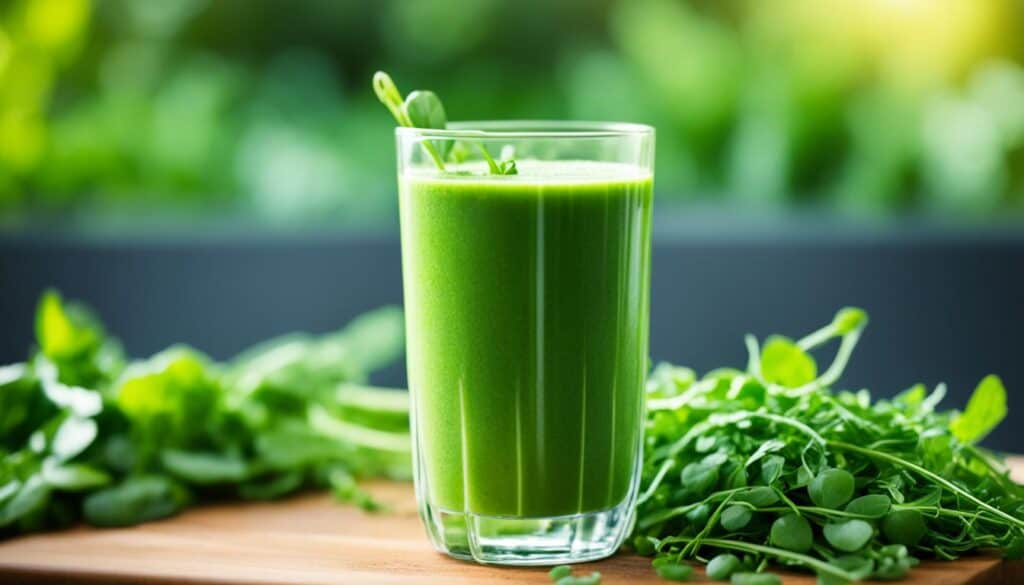
Incorporating pea shoots into a refreshing spring green smoothie not only adds a creamy texture but also provides a delicious burst of vitamins and nutrients. By combining pea shoots with a selection of wholesome ingredients like peanut butter, banana, orange juice, almond milk, and more, you can create a well-rounded and satisfying smoothie that fuels your body with essential healthy fats, protein, and carbohydrates. Best of all, this versatile recipe can be easily customized to accommodate different dietary preferences such as vegan, paleo, gluten-free, dairy-free, and sugar-free options.
Spring Green Smoothie Recipe
Try this refreshing and nutritious spring green smoothie recipe:
| Ingredients | Quantity |
|---|---|
| Pea shoots | 1 cup |
| Peanut butter | 1 tablespoon |
| Banana | 1 ripe |
| Orange juice | 1/2 cup |
| Almond milk | 1/2 cup |
| Wheatgrass powder | 1 teaspoon |
| Maca powder | 1 teaspoon |
| Maple syrup | 1 tablespoon (optional) |
Instructions:
- Combine all the ingredients in a blender.
- Blend until smooth and creamy.
- Pour into a glass and enjoy!
Feel free to experiment with additional healthy toppings or ingredients to suit your taste preferences. Be creative and make the most out of the vibrant flavors and goodness of pea shoots in your spring green smoothie.
Growing Pea Shoots at Home
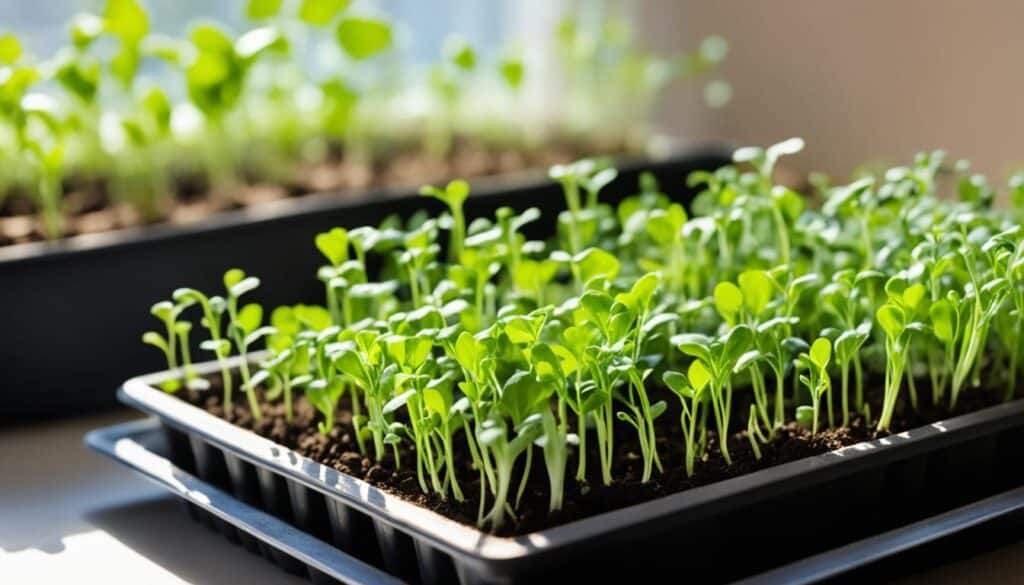
Growing your own pea shoots at home is a quick and easy way to enjoy nutrient-dense microgreens all year round. With just a few simple steps and minimal equipment, you can cultivate these delicious and healthy greens right in your own kitchen.
Containers and Equipment
Pea shoots can be grown in various containers, depending on your preference and the space available. Mason jars, seed sprouters, or shallow trays are all suitable options. When choosing containers, ensure they have drainage holes to prevent waterlogging.
To start your pea shoots, you’ll need some key equipment:
- Jars with sprouting lids or cheesecloth
- Seed sprouters
- Soil-less potting mix
- Watering can or mister
- Plastic domes or wrap
- Labels and scissors
- Oscillating fan for air circulation
These tools will provide the ideal environment for successful pea shoot growth, ensuring they receive adequate moisture, airflow, and protection from environmental factors.
Organic Pea Seeds
Using organic pea seeds specifically intended for sprouting or microgreens is highly recommended. These seeds are untreated and free from harmful chemicals, ensuring that your homegrown pea shoots are not only delicious but also free from unwanted contaminants.
The Growing Process
Now that you have all the necessary equipment and organic pea seeds, it’s time to start the growing process:
- Fill your chosen container with a moist soil-less potting mix, ensuring it’s loose and well-draining.
- Sow the organic pea seeds densely on top of the potting mix, gently pressing them into the soil without burying them too deep.
- Cover the container with a plastic dome or wrap to create a mini greenhouse effect. This helps retain moisture and provides a warm environment for germination.
- Place the container in a location with indirect sunlight or under grow lights. Avoid direct sunlight, as it can scorch the young shoots.
- Water the pea shoots regularly using a watering can or misting spray to keep the soil evenly moist but not waterlogged.
- Remove the plastic dome or wrap once the pea shoots begin to emerge. This allows for proper air circulation and prevents mold or fungus growth.
- Label your container to keep track of the variety and date of sowing.
- Use scissors to harvest the pea shoots when they reach several inches tall, usually within 7-10 days after sowing.
Remember to provide regular airflow to your pea shoots by using an oscillating fan. This helps strengthen the shoots and promotes healthy growth.
Growing pea shoots at home is not only rewarding but also allows you to enjoy these nutrient-dense greens at their freshest. With just a little time and effort, you can have a continuous supply of delicious and healthy pea shoots all year long.
Steps to Grow Pea Sprouts
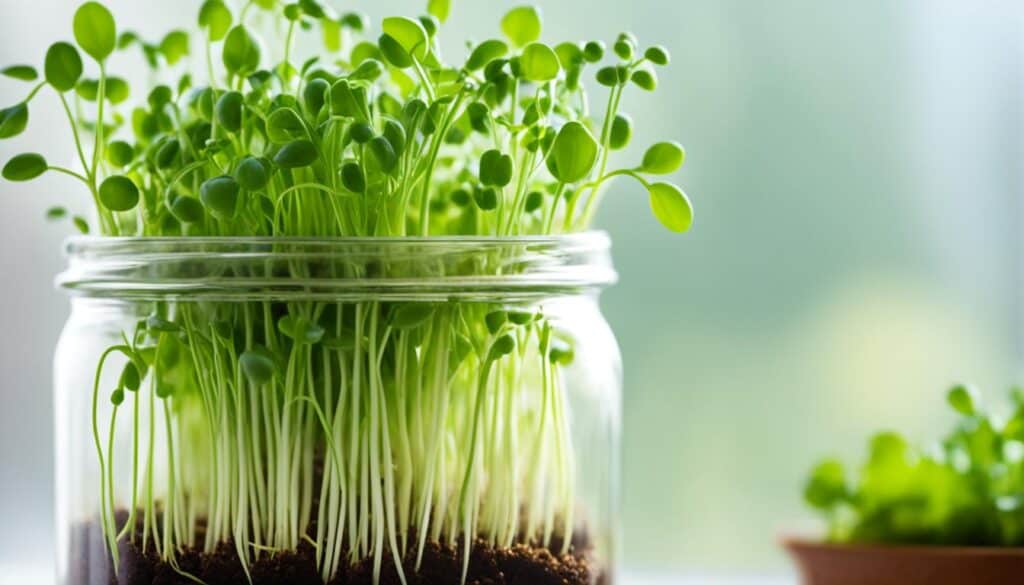
Growing pea sprouts is a straightforward process that can be done right in your own kitchen. Follow these simple steps to enjoy fresh and crunchy pea sprouts in just a few days.
1. Soaking the Seeds
To begin, place the pea seeds in a clean jar and cover them with water. Let the seeds soak for about 8-12 hours or overnight. This soaking process helps to kickstart the germination process.
2. Rinsing and Draining
After soaking, drain the water from the jar and rinse the seeds thoroughly with fresh water. Use a sprouting lid or a sprouting tray to cover the top of the jar, allowing airflow and preventing contamination.
3. Germination
Keep the jar away from direct sunlight and place it in a warm spot. Continue to rinse and drain the seeds twice a day to keep them moist. This rinsing process ensures that the sprouts receive enough water for germination while preventing mold growth.
4. Sunlight and Daily Care
Once the seeds start to sprout, move the jar to an area with indirect sunlight. Every day, rinse and drain the sprouts to maintain their moisture levels and remove any trapped gases.
5. Harvesting
After about 2-3 days, the sprouts will develop white roots and reach a desirable length. At this stage, they are ready to be harvested. Rinse the sprouts one final time and gently remove any remaining seed husks before enjoying their fresh taste and crisp texture.
Here’s a helpful table summarizing the steps to grow pea sprouts:
| Steps | Description |
|---|---|
| 1. Soaking the Seeds | Cover the seeds with water and let them soak for 8-12 hours or overnight. |
| 2. Rinsing and Draining | Drain the water and rinse the seeds thoroughly. Use a sprouting lid or tray to cover the jar. |
| 3. Germination | Keep the jar away from direct sunlight and rinse the seeds twice daily for germination. |
| 4. Sunlight and Daily Care | Move the sprouts to an area with indirect sunlight and continue rinsing and draining them daily. |
| 5. Harvesting | Rinse the sprouts one final time, remove seed husks, and enjoy the fresh pea sprouts! |
With a little patience and care, you can enjoy the delicious and nutritious pea sprouts right from your own kitchen. Happy sprouting!
Steps to Grow Pea Shoots
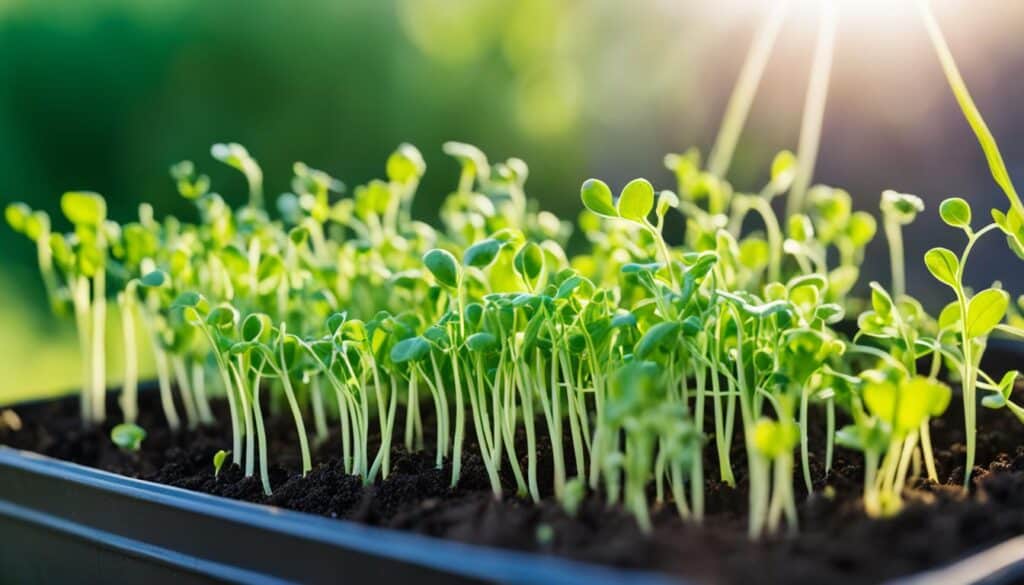
Are you ready to start growing your own pea shoots? Follow these simple steps to ensure a successful harvest of fresh, nutritious greens.
1. Choose Suitable Containers
Use containers with drainage holes to prevent waterlogging and ensure proper root development. Options include shallow trays, planting pots, or even repurposed food containers.
2. Prep the Growing Medium
Fill your chosen containers with a moist, well-draining growing medium. A mixture of potting soil, compost, and perlite works well for pea shoots.
3. Sow the Seeds
Densely sow the pea seeds onto the surface of the growing medium. Press them lightly into the soil and cover them with a thin layer of soil or vermiculite.
4. Provide Adequate Watering
Water the seeds gently but regularly, keeping the growing medium consistently moist. Be careful not to overwater, as this can lead to fungal diseases. A spray bottle or watering can with a fine nozzle is ideal for pea shoots.
5. Ensure Proper Germination
Place the containers in a sunny window or under grow lights to provide sufficient sunlight for germination. Keep the temperature around 65-75°F (18-24°C) for optimal growth.
6. Daily Care and Maintenance
Continue to water the pea shoots regularly, ensuring the soil stays moist but not waterlogged. Provide good air circulation by lightly misting them with water or using an oscillating fan on low speed.
7. Harvesting
The pea shoots will be ready for harvest when they reach a height of several inches and develop their first set of true leaves. Use clean scissors or shears to cut the shoots just above soil level, leaving the roots in the soil for regrowth.
8. Non-Stop Supply
To ensure a constant supply of pea shoots, start a new tray every two weeks. This staggered planting schedule will provide you with a continuous harvest and a non-stop supply of fresh greens.
Follow these steps, and soon you’ll be enjoying your own homegrown pea shoots, ready to add a nutritious and flavorful touch to your favorite dishes.
Types of Peas for Sprouts and Shoots
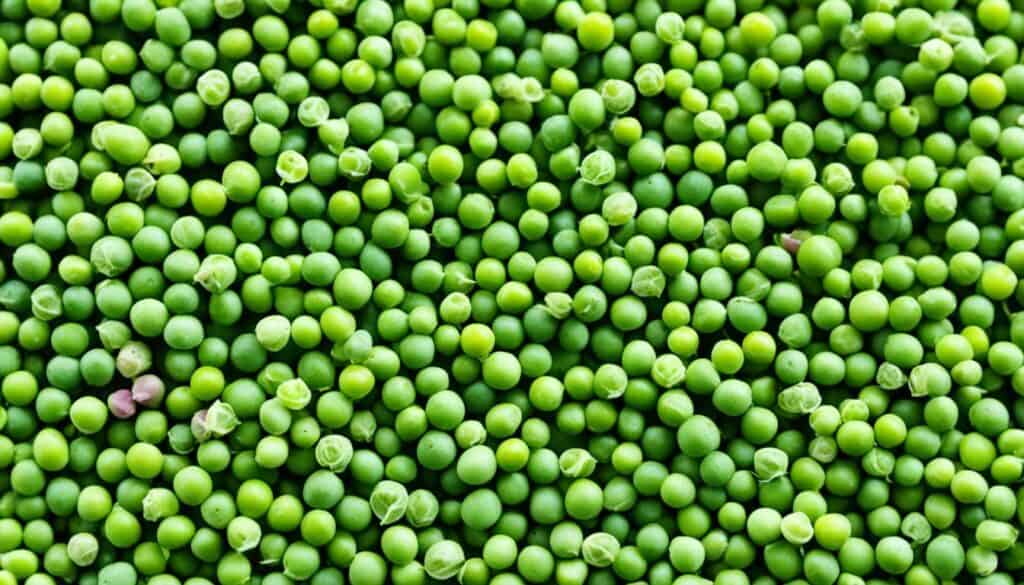
When it comes to growing pea sprouts and shoots, there are several types of peas that you can choose from. These varieties offer different flavors, colors, and textures, allowing you to experiment and find your preferred taste. Here are some recommended types of peas for sprouting and growing shoots:
- Dwarf Gray Sugar pea: This variety produces sweet and tender sprouts with delicate tendrils.
- Green pea: Green peas are a classic choice for sprouting, offering a fresh and vibrant flavor.
- Speckled pea: These peas have a unique appearance with speckles on their skin, and they add a visually appealing touch to your sprouts and shoots.
- Yellow pea: Yellow peas provide a slightly milder flavor compared to green peas and can be a great choice for those who prefer a subtler taste.
- Petite Snap-Green pea: This variety is known for its crispness and delicious pea flavor, making it a popular option for sprouting and adding to salads.
- Tendril pea: Tendril peas are valued for their delicate and curly tendrils, which add an elegant touch to your sprouts and dishes.
When selecting peas for sprouting and growing shoots, it’s advisable to choose organic seeds that are specifically intended for sprouting or microgreens. Organic seeds ensure that you are using high-quality, chemical-free seeds that will yield nutritious and flavorful sprouts and shoots.
With these different types of peas, you can enjoy a variety of flavors and textures in your sprouts and shoots. Whether you prefer the sweetness of Green peas or the delicate tendrils of Dwarf Gray Sugar peas, there’s a pea variety to suit your taste. Experiment with different types and discover your favorites as you embark on your journey of growing and enjoying fresh pea sprouts and shoots at home.
Equipment for Growing Pea Sprouts and Shoots
When it comes to growing pea sprouts and shoots, having the right equipment is essential. Whether you prefer sprouts or shoots, there are various tools and materials that will help you cultivate your own fresh and nutritious greens.
For sprouting pea seeds, you can use mason jars or dedicated sprouting jars with lids, which allow for proper ventilation and drainage. To ensure proper airflow and prevent mold growth, you can cover the jar with cheesecloth or a mesh material. This will keep your sprouts fresh and healthy.
If you prefer seed sprouters, there are different types available on the market. These sprouting devices provide optimal conditions for germination and growth, allowing you to easily harvest your sprouts.
For growing pea shoots, you will need shallow containers with drainage holes. This will ensure that excess water can escape, preventing root rot and other issues. Fill the containers with a soil-less potting mix, which is lightweight and provides the necessary nutrients for the shoots.
To water your shoots, you can use a watering can or a mister, ensuring that the soil remains moist but not saturated. Optional items such as clear domes can be used to create a greenhouse effect, promoting faster growth and providing protection.
Other useful tools for growing pea sprouts and shoots include labels for organizing and identifying different varieties, scissors for easily harvesting your greens, and an oscillating fan for continuous air circulation, which helps prevent disease and mold.
With the right equipment in hand, you’ll be well-prepared to embark on your journey of growing pea sprouts and shoots at home. Experiment with different methods and find what works best for you, and soon enough, you’ll be enjoying your own bounty of fresh and nutritious greens.
Conclusion
Pea shoots are a highly nutritious green that is not only delicious but also incredibly versatile. Growing pea shoots at home is a simple and rewarding DIY project that allows you to enjoy the health benefits of these nutrient-dense microgreens.
With their high levels of vitamins and antioxidants, pea shoots are a fantastic addition to your diet. They provide a concentrated dose of essential nutrients, including vitamin K, vitamin C, vitamin A, and vitamin E, among others. Incorporating pea shoots into your meals can support a healthy immune system, promote cardiovascular health, and reduce inflammation.
The convenience of growing pea shoots at home cannot be overstated. You can have a consistent supply of fresh and nutritious greens right at your fingertips. Whether you want to add them to salads, sandwiches, stir-fries, or smoothies, pea shoots offer a delicious taste and a vibrant burst of flavor to any dish.
In conclusion, pea shoots are a wonderful addition to any healthy diet. Their nutrient density, easy DIY growth, and wide range of culinary applications make them a superfood that everyone can enjoy. So, why not start growing your own pea shoots at home today and experience the satisfaction of harvesting these nutritious greens for yourself?

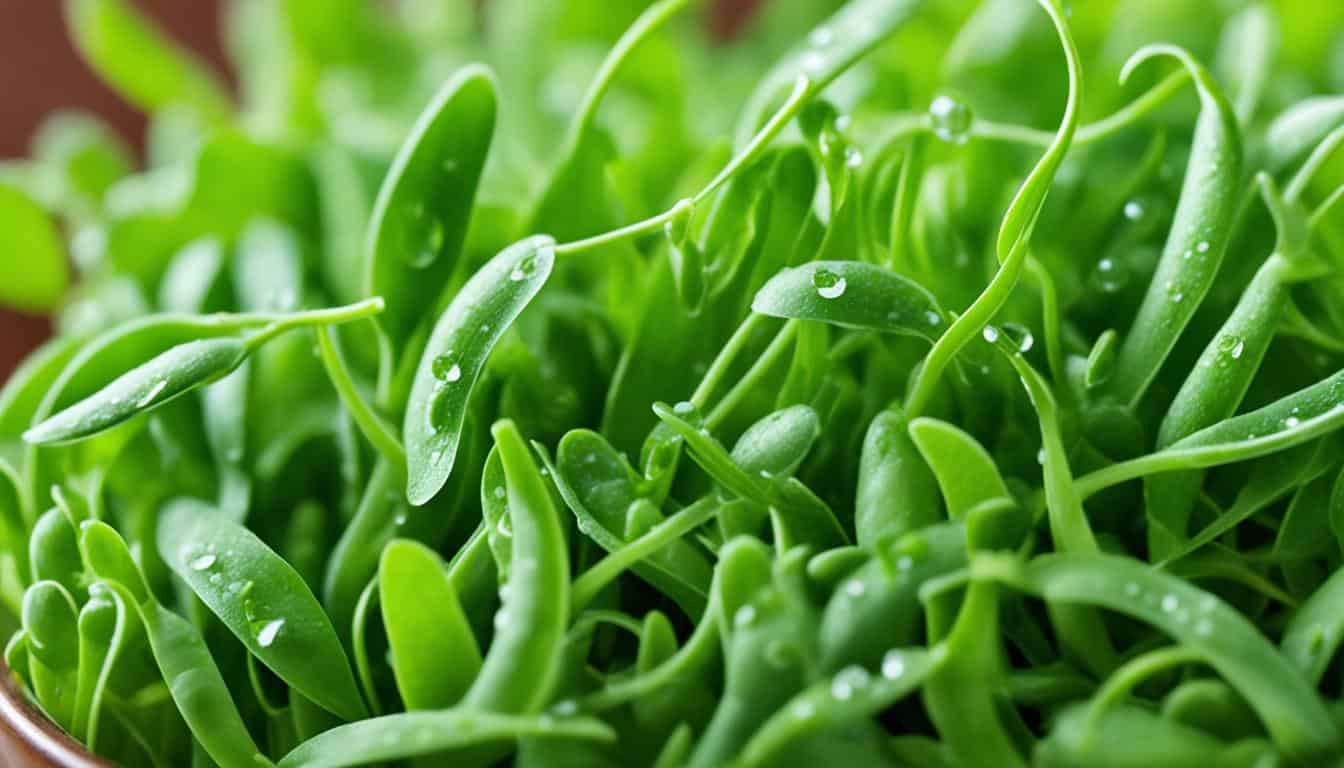



Leave a Reply